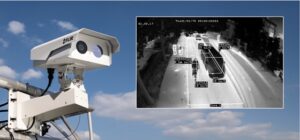Norway is introducing artificial intelligence in its road tunnel incident detection systems with the upgrade of the Damsgård Tunnel in Bergen. The project will implement AI-enhanced dual-vision cameras, a first in the country, as part of a broader modernization effort that includes ventilation, lighting, and drainage improvements.
The Damsgård Tunnel, a 2.3-kilometer stretch of Norwegian National Road 555, has been operational since 1992. As part of its 2024 upgrade, approximately 80 AI-powered cameras from sensor specialist FLIR will be installed. These cameras integrate thermal and visual imaging, using deep learning algorithms to detect stopped vehicles, wrong-way drivers, queues, pedestrians, and smoke or fires in their early stages.
Norway has a long history of using automatic incident detection in its extensive tunnel network. The first such system was installed in the Ekeberg Tunnel near Oslo in 1995, and its effectiveness was demonstrated the following year when a bus fire triggered an automated alert, enabling a swift response. Since a 2004 European directive on road tunnel safety, incident detection technology has continued to evolve, incorporating thermal imaging to improve accuracy, especially in challenging lighting conditions.
Thermal cameras, which detect heat rather than light, have proven particularly effective in tunnels, where shadows, glare, and smoke can obstruct traditional visual cameras. They allow operators to detect vehicles and pedestrians even in smoke-filled conditions and can identify fires at the ignition stage. Over time, dual-vision cameras that combine both thermal and visual imaging have been deployed to enhance detection capabilities. FLIR’s AI-driven TrafiBot Dual AI cameras, now being installed in the Damsgård Tunnel, represent the latest advancement.

+
AI-driven detection systems offer improvements over earlier generations, which relied on pixel-based image analysis. Modern AI cameras use object detection techniques, allowing for more precise identification of vehicles, pedestrians, and incidents. These systems also generate detailed traffic data, enabling predictive analytics to anticipate potential accidents. By distinguishing between routine traffic activity and actual incidents, AI helps reduce false alarms, improving efficiency for tunnel operators.
The AI-powered cameras are also capable of classifying different types of vehicles with high accuracy and predicting their movements based on speed and trajectory. This enables early warnings for potential collisions or hazardous conditions. In addition to incident response, the data collected by these systems can inform traffic planning and risk management efforts.
With AI-based detection systems becoming increasingly prevalent, their effectiveness will depend on the quality of data used for training. FLIR has developed its AI models using proprietary datasets compiled over more than 30 years, ensuring accuracy in a variety of conditions. As these datasets continue to grow, the performance of AI-driven traffic monitoring systems is expected to improve.
The introduction of AI-enhanced dual-vision cameras in the Damsgård Tunnel marks a new phase in Norway’s tunnel safety efforts. With an average daily traffic volume of 40,000 vehicles, the AI-based system is expected to improve incident detection and emergency response, contributing to safer road conditions.

